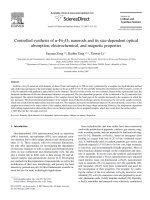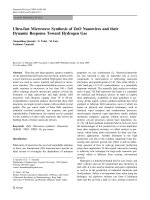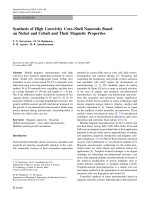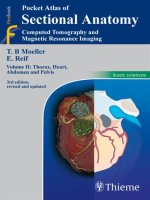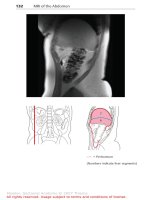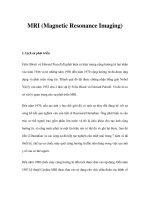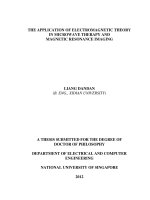Synthesis of superparamagnetic nanostructures and their magnetic resonance imaging applications
Bạn đang xem bản rút gọn của tài liệu. Xem và tải ngay bản đầy đủ của tài liệu tại đây (7.25 MB, 202 trang )
S
YNTHESIS OF SUPERPARMAGNETIC NANOSTRUCTURES AND
THEIR
MAGNETIC RESONANCE IMAGING APPLICATIONS
C
HOO SHI GUANG, EUGENE
N
ATIONAL UNIVERSITY OF SINGAPORE
2012
2
S
YNTHESIS OF SUPERPARMAGNETIC NANOSTRUCTURES AND
THEIR
MAGNETIC RESONANCE IMAGING APPLICATIONS
C
HOO SHI GUANG, EUGENE
(B.
APPL. SCI., HONS), NUS
A
THESIS SUBMITTED FOR
T
HE DEGREE OF DOCTOR OF PHILOSOPHY (PH.D)
D
EPARTMENT OF MATERIALS SCIENCE AND ENGINEERING
N
ATIONAL UNIVERSITY OF SINGAPORE
2012
i
ACKNOWLEDGMENTS
To Dr. Xue Jun Min. I wish to give to you my deepest thanks. It is an honor to be
your first graduating Ph.D. student. You had taught me during my undergraduate
studies, and given advice on my FYP even though you were not my assigned advisor.
You have since then been the key motivator of my graduate studies. I must thank you
again for responding so positively to all my bad experimental results. I deeply
appreciate all your contributions of time, ideas, and financial support to make my
Ph.D. experience both productive and stimulating. You are more than a teacher to me.
To Dr. Borys Shuter. I am particularly indebted to you in my later work regarding
MRI measurements. I thank you for unselfishly putting aside your work to patiently
carry out MRI measurements with me and then discuss the results. I particularly
dedicate this thesis to you, for without your expertise and guidance to kickstart my
MRI studies, this thesis would not have come to fruition. I wish you a long and happy
retirement!
I wish to thank Dr. Chuang Kai-Hsiang and his research team of the Magnetic
Resonance Imaging group in the Singapore Bioimaging Consortium (SBIC). I am
grateful for all their help in conducting the MR spectroscopic imaging in the final
part of my Ph.D studies.
I would like to thank the NMR laboratory (Department of Chemistry, NUS) for their
help in my NMR measurements. Particularly, I would like to thank Mdm. Han Yanhui
for attending to my frequent service requests and then performing the measurements
and processing the results ever so promptly.
ii
I would like to thank the entire team of lab technologists in the Advanced Materials
Characterization Laboratory in my department. I thank Serene Chooi for
coordinating the safety of the labs. I thank Mr. Chan for keeping the computers and
facilities running smoothly. I thank Mdm. He Jian for providing a clean and tidy
biological lab for my cell assays. I thank Agnes for all her help for SEM and Zetasizer.
I thank Chen Qun for his assistance on my XRD and VSM experiments. I thank Yeow
Koon for all his help on FT-IR and UV-Vis experiments. I thank Henche for all his
help on the TGA experiments. I thank Roger for maintaining the smooth running of
our wet-lab. Additionally, I would also like to thank Yin Hong and Brenda for all their
technical assistance before they left the department.
I would also like to thank Dr. Zhang Jixuan of the TEM lab for all her assistance,
guidance, and freedom granted in the use of the TEM equipment. I am always looking
forward to the TEM sessions.
To Xiaosheng, Jiaquan, Sheng Yang, Li Meng, Chen Yu, and Erwin of the
Nanostructured Biomedical Materials Lab. I thank all my good labmates for being
cooperative during my time as the safety representative of the group. I am grateful for
all the meal gatherings that were organized within our group, and it just seems
amazing how we could come up with so many excuses to go out together for a good
meal. I had a great time working and chilling out with all of you!
Lastly, I would like to thank all my other close friends (both research and non-
research) for all their support and encouragement during my life as a research
student. I thank you all for giving me a semblance of normal life in the stereotypical
lifeless life of a Ph.D. student. Mazel tov!
iii
TABLE OF CONTENTS
Acknowledgments i
Table of Contents iii
Summary vi
List of Related Publications viii
List of Tables x
List of Figures xii
List of Abbreviations xix
CHAPTER 1: Introduction 1
1.1 Nanoprobes for Clinical Diagnostic Imaging 1
1.2 Magnetic Resonance Imaging 5
1.2.1 T
1
Contrast Effect 7
1.2.2 T
2
Contrast Effect 8
1.3 Advances in Contrast Agents for Magnetic Resonance Imaging 11
1.3.1 Off-Resonance Saturation Contrast Enhancement 11
1.3.2 Chemical Exchange Saturation Transfer (CEST) 13
1.3.3 Heteronuclei Magnetic Resonance Spectroscopy Imaging 14
1.3.4 Magnetic Field-Induced Magnetic Resonance Spectroscopic Imaging 15
1.4 Project Motivations and Designs 16
1.5 Research Objectives 20
CHAPTER 2: Experimental 22
2.1 Materials 22
2.2 Materials Synthesis 23
2.2.1 Synthesis of 4 nm Fe
3
O
4
Nanoparticles 23
2.2.2 Synthesis of 7 nm Fe
3
O
4
Nanoparticles 24
2.2.3 Synthesis of MnFe
2
O
4
Nano-Octahedrons 24
2.2.4 Synthesis of Silver Nanoparticles 25
2.2.5 Synthesis of Functional Amphiphilic Brush Copolymer 26
2.2.6 Synthesis of Fluorescent Amphiphilic Brush Copolymer 27
2.2.7 Synthesis of PEG-Conjugated Amphiphilic Brush Copolymer 29
iv
2.3 Phase Transfer of Single Hydrophobic Nanoparticles 30
2.4 Preparation of Nanoparticle/Polymer Spherical Nanocomposites 31
2.5 Characterization 32
2.5.1 Chemical Analysis 32
2.5.2 Morphological Study 33
2.5.3 Magnetic Properties 35
2.5.4 Optical Properties 36
2.5.5 Thermogravimetric Analysis 36
2.5.6 Colloidal Stability 37
2.5.7 Water Absorption Studies 37
2.5.8 Cell Viability Assays 38
2.5.9 Cell Labelling 39
2.5.10 Magnetic Relaxivity Studies 39
2.5.11 MRI Phantom Studies 40
CHAPTER 3: Synthesis of Magnetic Nanoparticles and Functional
Amphiphilic Brush Copolymer 41
3.1 Motivations and Design of Experiment 41
3.2 Synthesis of Iron Oxide Nanoparticles 47
3.2.1 Characterization of Iron Oxide Nanoparticles 49
3.3 Synthesis of Manganese Ferrite Nano-Octahedrons 52
3.3.1 Characterization of Manganese Ferrite Nano-Octahedrons 55
3.4 Synthesis of Functional Amphiphilic Brush Copolymer 58
3.4.1
1
H NMR Analysis of Functional Brush Copolymer 59
3.4.2 FT-IR Analysis of Functional Brush Copolymer 61
3.5 Remarks 63
CHAPTER 4: Formation of Composite Superparamagnetic Nanoclusters 65
4.1 Motivations and Design of Experiment 65
4.2 Effect of Oil-to-Water Ratio 68
4.3 Effect of Polymer Concentration 71
4.4 Effect of Nanoparticle Concentration 75
4.5 Effect of SPION Size 78
4.6 Thermogravimetric Determination of Loading Density 81
4.7 Colloidal Stability Studies 83
4.7.1 Colloidal Stability in Water and PBS 84
v
4.7.2 Colloidal Stability in 3 Tesla Magnet 85
4.7.3 Stability Against Protein Adsorption 86
4.8 pH Stability Studies 88
4.9 Remarks 90
CHAPTER 5: Superparamagnetic Nanocomposite Structures for Enhanced T
2
Contrast Effect and Fluorescent Imaging 92
5.1 Motivations and Design of Experiment 92
5.2 Preparation and Characterization of Iron Oxide Nanocomposites 95
5.3 Magnetic Properties of Iron Oxide Nanoclusters 98
5.4 Calculation of Intra-Particle Separation 103
5.5 Relationship Between Magnetic Properties and Intra-Particle Separation in
IONCs 105
5.6 MRI Relaxivity Studies 109
5.7 Fluorescent Tagging of Cells for Dual Modal Imaging 121
5.8 Remarks 125
CHAPTER 6: Study of Magnetic Nanostructures for Off-Resonance MR
Spectroscopic Imaging 127
6.1 Motivations and Design of Experiment 127
6.2 Preparation and Characterization of Manganese Ferrite Nanocomposites 134
6.3
1
H NMR Spectroscopy Study of Magnetic Nanocomposites 142
6.4 MR Spectroscopic Imaging Study 149
6.5 Water Absorption Studies of the MFNC Nanocomposites 150
6.5.1 Water Swelling Study 151
6.5.2 Water Permeability Tests 152
6.5.3 Tuning of Hydrophilicity by Conjugation with PEG 155
6.6 pH Stability 157
6.7 Colloidal Stability 159
6.8 Cell Cytotoxicty 160
6.9 Remarks 161
CHAPTER 7: Conclusions and Future Work 163
7.1 Project Conclusions 163
7.2 Possible Improvements for Future Work 166
Biobliography 170
vi
SUMMARY
In this thesis, the study was aimed at improving current superparamagnetic contrast
agents utilized in magnetic resonance imaging (MRI). For this purpose, the synthesis
of well-defined spherical magnetic nanocomposite structures was proposed. The
objective was to study the magnetic behaviour of such a nanostructure based on
superparamagnetic nanocrystal (SPMN) assemblies in a polymeric matrix. By varying
the packing density of SPMNs within a sphere, the separation distance between the
nanocrystals could be readily controlled. Through examining the properties of such
nanostructures, it was possible to gain deeper insights on the magnetic interaction
behavior between SPMNs. Hence, the research work was mainly focused on
investigating and exploiting unique magnetic behaviours of SPMNs for enhancing
MRI contrast effects.
The key advantage of SPMNs over other MRI contrast agents is its high molar
relaxivity. Due to the strong magnetic fields induced by SPMNs, they distort local
field patterns, which is useful in MRI because it affects the spin behaviour of protons.
The most common source of protons in the body is hydrogen in water, with a net spin
of ½. When placed in a magnetic field, protons precess at a frequency that is
dependent on the magnitude of the external field. Hence, by disturbing the local field
through the introduction of SPMNs, the protons experience changes in precession
frequency and consequently lose phase coherence with respect to the bulk pool. This
phenomenon is known as dephasing and results in the spreading of MR spectral
signals. Based on such magnetic behaviour, two mechanisms were proposed to
enhance MRI contrast using SPMNs.
vii
The first was simply to maximise the rate at which protons dephase. The
region that undergoes rapid spin dephasing would appear dark in a bright MR image
so that the SPMN-targeted location could be distinguished. Assembled secondary
structures of SPMNs were found to display unusually good proton dephasing effects.
However, past studies were based on uncontrolled aggregation of SPMNs that were
generally irregular in shape and size, which made it impossible to correlate the MR
effects with the structure of magnetic contrast agents. Herein, the proposal of well-
structured and uniform magnetic composite nanospheres addressed this issue.
The second way could be termed as “rephasing”. SPMNs typically cause
random shifts in the precession frequencies of protons, which results in a wide range
of frequencies. However, if one can recover the loss in phase coherence and restore it
at a frequency that is different from the natural precession frequency of water, an
alternative signal could be employed for detection of the contrast agent. The proposed
magnetic nanocomposites structure could hypothetically produce such a unique effect
and be potentially useful for dual modal MR spectroscopic imaging.
As such, this thesis was premised on fabricating uniform and well-dispersed
superparamagnetic nanocomposite structures as the key materials component. The
particles were broadly characterized in terms of size, morphology, composite structure,
magnetic properties, pH stability, colloidal stability and cytotoxicity. Finally, they
were analyzed for its potential as multifunctional and multimodal imaging probes for
detection based on the MRI platform.
viii
LIST OF RELATED PUBLICATIONS
E. S. G. Choo, E. Peng, R. Rajendran, P. Chandrasekharan, C. T. Yang, J. Ding,
K. H. Chuang, J. M. Xue, “Superparamagnetic Nanostructures for Off-Resonance
Magnetic Resonance Spectroscopic Imaging”, DOI: Advance Functional
Materials 10.1002/adfm.201200275, accepted on 13
th
Aug 2012
E. S. G. Choo, X. S. Tang, Y. Sheng, B. Shuter, J. M. Xue, “Controlled Loading
of Superparamagnetic Nanopaticles in Fluorescent Nanogels as Effective T
2
-
Weighted MRI Contrast Agents”, Journal of Materials Chemistry, 21, 2310-2319
(2011)
E. S. G. Choo, B. Yu, J. M. Xue, “Synthesis of Poly(acrylic acid) (PAA)
Modified Pluronic P123 Copolymers for pH-Stimulated Release of Doxorubicin”,
Journal of Colloid and Interface Science, 358, 462-470 (2011)
E. Peng, E. S. G. Choo, P. Chandrasekharan, C. T. Yang, K. H. Chuang, J. M.
Xue, “Synthesis of Manganese Ferrite/Graphene Oxide Nanocomposites for
Biomedical Applications”, DOI: Small 10.1002/smll.201201427, accepted on 21
st
Aug 2012
X. L. Liu, H. M. Fan, J. B. Yi, Y. Yang, E. S. G. Choo, J. M. Xue, D. D. Fan, J.
Ding, “Optimization of Surface Coating on Fe
3
O
4
Nanoparticles for High
Performance Magnetic Hyperthermia Agents”, Journal of Materials Chemistry, 22,
8235-8244 (2012)
X. S. Tang, K. Yu, Q. H. Xu, E. S. G. Choo, G. K. L. Goh, J. M. Xue, “Synthesis
and Characterization of AgInS
2
-ZnS Heterodimers with Tunable
Photoluminescence”, Journal of Materials Chemistry, 21, 11239-11243 (2011)
X. S. Tang, E. S. G. Choo, L. Li, J. Ding, J. M. Xue, “Synthesis of ZnO
Nanoparticles with Tunable Emission Colors and Their Cell Labeling
Applications”, Chemistry of Materials, 22, 3383-3388 (2010)
J. Q. Yuan, E. S. G. Choo, X. S. Tang, Y. Sheng, J. Ding, J. M. Xue, “Synthesis
of ZnO–Pt Nanoflowers and their Photocatalytic Applications”, Nanotechnology,
21, 185606-185615 (2010)
L. Li, E. S. G. Choo, X. S. Tang, J. Ding, J. M. Xue, “Ag/Au-Decorated
Fe
3
O
4
/SiO
2
Composite Nanospheres for Catalytic Applications”, Acta Materialia,
58, 3825-3831 (2010)
X. S. Tang, E. S. G. Choo, L. Li, J. Ding, J. M. Xue, “One-Pot Synthesis of
Water-Stable ZnO Nanoparticles via a Polyol Hydrolysis Route and their Cell
Labeling Applications”, Langmuir, 25, 5271-5275 (2009)
L. Li, E. S. G. Choo, X. S. Tang, J. Ding, J. M. Xue, “A Facile One-Step Route to
Synthesize Cage-Like Silica Hollow Spheres Loaded with Superparamagnetic
ix
Iron Oxide Nanoparticles in their Shells”, Chemical Communications, 8, 938-940
(2009)
D. Maity, E. S. G. Choo, J. B. Yi, J. Ding, J. M. Xue, “Synthesis of Magnetite
Nanoparticles via a Solvent-Free Thermal Decomposition Route”, Journal of
Magnetism and Magnetic Materials, 321, 1256-1259 (2009)
L. Li, E. S. G. Choo, J. B. Yi, J. Ding, X. S. Tang, J. M. Xue,
“Superparamagnetic Silica Composite Nanospheres (SSCNs) with Ultrahigh
Loading of Iron Oxide Nanoparticles via an Oil-in-DEG Microemulsion Route”,
Chemistry of Materials, 20, 6292-6294 (2008)
L. Li, E. S. G. Choo, Z. Y. Liu, J. Ding, J. M. Xue, “Double-Layer Silica Core-
Shell Nanospheres with Superparamagnetic and Fuorescent Functionalities”,
Chemical Physics Letters, 461, 114-117, (2008)
x
LIST OF TABLES
Table 3-1: Basic characteristics of the as-synthesized Fe
3
O
4
nanoparticles.
(Page 52)
Table 3-2: Basic characteristics of the as-synthesized MnFe
2
O
4
nanoparticles.
(Page 58)
Table 4-1: Summary of nanosphere samples prepared using different oil-to-water
ratios in the mini-emulsion.
(Page 69)
Table 4-2: Summary of nanosphere samples prepared using variable amounts of
copolymer in the mini-emulsion.
(Page 72)
Table 4-3: Summary of IONCs prepared using variable amounts of SPION-4nm in the
mini-emulsion.
(Page 76)
Table 4-4: Summary of IONCs prepared using variable amounts of SPION-7nm in the
mini-emulsion.
(Page 79)
Table 4-5: Summary of SPION loading weight percentage of the IONC-a and IONC-b
samples as determined by TGA.
(Page 83)
Table 5-1: Summary of the saturation magnetization (M
s
) values of SPION-4nm,
SPION-7nm and IONC samples as measured by VSM.
(Page 100)
Table 5-2: Summary of derived characteristics of SPION-4nm, SPION-7nm and the
IONC samples.
(Page 106)
Table 5-3: Summary of T
1
values obtained for Ferucarbotran, SPION-7nm, and
IONC-b samples with spin echo sequences (T
E
: 9.1 ms, T
R
: 100 ms - 6400 ms).
(Page 111)
Table 5-4: Summary of T
2
values obtained for Ferucarbotran, SPION-7nm, and
IONC-b samples with single echo pulse sequences (6 echoes; T
E
: 9.1 ms – 160 ms, T
R
:
1600 ms).
(Page 111)
xi
Table 5-5: Summary of T
2
*
values obtained for Ferucarbotran, SPION-7nm, and
IONC-b samples with a gradient echo sequence (8 echoes; T
E
: 4 ms – 80 ms, T
R
: 1600
ms).
(Page 112)
Table 5-6: Summary of R
1
values for Ferucarbotran, SPION-7nm, and IONC-b
samples.
(Page 113)
Table 5-7: Summary of R
2
values for Ferucarbotran, SPION-7nm, and IONC-b
samples.
(Page 113)
Table 5-8: Summary of R
2
*
values for Ferucarbotran, SPION-7nm, and IONC-b
samples.
(Page 114)
Table 5-9: Summary of relaxivity constants of the Ferucarbotran, SPION-7nm, and
IONC-b samples.
(Page 116)
Table 6-1: Summary of magnetic properties of MFNs and MFNCs.
(Page 139)
xii
LIST OF FIGURES
Figure 1-1: Flowchart illustrating the use of diagnostic imaging during the treatment
process of a diseased patient. Steps involving imaging are highlighted in gray.
(Page 2)
Figure 1-2: Schematic diagram illustrating a patient inside a MRI magnet subject to
strong magnetic field generated by a superconducting coil (Z). Gradients in the
uniform field within the coils are induced by addition coils in the X and Y directions.
(Page 5)
Figure 1-3: Schematic showing the determination of T
1
as the time taken for the
recovery of 63.2% of the longitudinal magnetization (M
z
).
(Page 7)
Figure 1-4: Schematic showing the determination of T
2
as the time taken for the loss
of 63.2% of the transverse magnetization (M
xy
) due to dephasing of the spin
precessions.
(Page 9)
Figure 2-1: Reaction scheme for the synthesis of amphiphilic brush copolymer,
PBMA-g-C12.
(Page 26)
Figure 2-2: Reaction scheme for the synthesis of the fluorescent amphiphilic
copolymer PBMA-g-(C12/FC).
(Page 28)
Figure 2-3: Reaction scheme for the synthesis of PEG-conjugated amphiphilic
copolymer PBMA-g-PEG.
(Page 29)
Figure 2-4: Schematic illustration for the formation of nanospheres via the oil-in-
water emulsion. The polymer and nanoparticles were initially dispersed in the oil
phase. Ultrasonication breaks the oil into minute droplets, which act as the spherical
template for the condensation and formation of the nanospheres in the water medium.
(Page 31)
Figure 3-1: Inverse spinel structure of Fe
3
O
4
. (Red spheres indicate O
2-
, yellow
tetrahedrons are sites occupied by Fe
3+
, and purple octahedrons are sites occupied by
Fe
2+
or Fe
3+
.)
(Page 42)
Figure 3-2: Schematic diagram illustrating the interleaving of multiple side chains of
the brush-structured copolymer with the surface ligands of the nanoparticles. Polymer
chain lengths and density of chains are not drawn to scale.
(Page 45)
xiii
Figure 3-3: (a) TEM image of 4 nm Fe
3
O
4
SPIONs synthesized at 265
o
C. (b) High
resolution TEM image of the 4 nm SPIONs showing the atomic lattice fringes. (c)
TEM image of 7 nm Fe
3
O
4
SPIONs synthesized at 300
o
C. (d) High resolution TEM
image of the 7 nm SPIONs showing the atomic lattice fringes. (Inset: Bar charts
showing the number size distribution profiles of the respective SPIONs)
(Page 48)
Figure 3-4: (a) XRD spectra of (1) SPION-4nm and (2) SPION-7nm. (b) M(H)
profiles of (1) SPION-4nm and (2) SPION-7nm.
(Page 50)
Figure 3-5: (a) TEM image of 6 nm MFNs. (b) High resolution TEM image of the 6
nm MFNs showing the atomic lattice fringes. (c) TEM image of 18 nm MFNs. (d)
High resolution TEM image of the 18 nm MFNs showing the atomic lattice fringes. (e)
TEM image of 30 nm MFNs. (f) High resolution TEM image of the 30 nm MFNs
showing the atomic lattice fringes. (Inset: Bar charts showing the number size
distribution profiles of the respective MFNs)
(Page 53)
Figure 3-6: (a) XRD spectra of (1) MFN-6nm, (2) MFN-18nm, and (3) MFN-31nm.
(Page 55)
Figure 3-7: (a) M(H) profiles of (1) MFN-6nm, (2) MFN-18nm, and (3) MFN-31nm.
(b) M(H) profiles of (1) MFN-6nm, (2) MFN-18nm, and (3) MFN-31nm.
(Page 57)
Figure 3-8:
1
H NMR spectrum of PBMA-g-(C12/FC) in DMSO-d
6
. (Solvent peaks:
DMSO-d
6
at 2.5 ppm, HOD at 3.3 ppm)
(Page 60)
Figure 3-9: FT-IR spectra of (i) PBMA-g-(C12/FC), (ii) PBMA, (iii) 1-dodecylamine,
and (iv) fluoresceinamine.
(Page 61)
Figure 4-1: Schematic diagram illustrating the formation of magnetic nanocomposites
through the oil-in-water mini-emulsion/solvent evaporation process.
(Page 66)
Figure 4-2: SEM images of nanospheres synthesized using different oil-to-water ratios.
(a) R-1 (1:15); (b) R-2 (1:10); (c) R-3 (1:5); and (d) R-4 (1:2). (e) Z-average sizes of
the samples obtained by DLS against amount of copolymer injected. (Scale bars =
200 nm)
(Page 70)
Figure 4-3: SEM images of nanospheres synthesized using different amounts of
polymer. (a) P-1 (2.5 mg); (b) P-2 (5 mg); (c) P-3 (10 mg); (d) P-4 (25 mg); (e) P-5
(40 mg); (f) P-6 (50 mg); (g) P-7 (60 mg); and (h) P-8 (100 mg). (i) Z-average sizes
obtained by DLS against the amount of copolymer injected. (Scale bars = 1 μm)
(Page 73)
xiv
Figure 4-4: SEM images and the corresponding size distribution curves (DLS) of
IONCs synthesized using different amounts of SPION-4nm. (a) IONC-a1; (b) IONC-
a2; (c) IONC-a3; (d) IONC-a4; (e) IONC-a5; and (f) IONC-a6. (Scale bars = 500 nm)
(Page 77)
Figure 4-5: TEM images of (a) IONC-a1, and (b) IONC-a6 illustrating the different
loading density of SPION-4nm inside the polymer sphere.
(Page 78)
Figure 4-6: SEM images and the corresponding size distribution curves (DLS) of
IONCs synthesized using different amounts of SPION-7nm. (a) IONC-b1; (b) IONC-
b2; (c) IONC-b3; (d) IONC-b4; (e) IONC-b5; and (f) IONC-b6. (Scale bars = 500 nm)
(Page 80)
Figure 4-7: TEM images of IONCs synthesized using different amounts of SPION-
7nm. (a) IONC-b1; (b) IONC-b2; (c) IONC-b3; (d) IONC-b4; (e) IONC-b5; and (f)
IONC-b6. (Scale bar = 20 nm)
(Page 81)
Figure 4-8: TGA profiles of (a) SPION-4nm and IONC-a samples in increasing order
of SPION composition from bottom to top, and (b) SPION-7nm and IONC-b samples
in increasing order of SPION composition from bottom to top.
(Page 82)
Figure 4-9: DLS intensity-weighted size measurements and zeta potential
measurements of IONC-b5 incubated in millipore water and PBS at 25
o
C for up to 10
days.
(Page 84)
Figure 4-10: R
2
relaxation rate (
2
T
1
) as a function of iron concentration [Fe] for (a)
IONC-b1, (b) IONC-b2, (c) IONC-b3, (d) IONC-b4, (e) IONC-b5, and (f) IONC-b6
before (×) and after (∆) being left standing in a 3T magnet for 17 h. T
2
values were
obtained using the CPMG spin-echo sequence (32 echoes; T
E
: 9.2 ms, T
R
: 3000 ms).
(Page 85)
Figure 4-11: DLS intensity-weighted size measurements of IONC-b5 incubated in
PBS (with and without 10% FBS) at 37
o
C for up to 2 days.
(Page 87)
Figure 4-12: (a) DLS intensity-weighted size measurements of IONC-b5 incubated in
different pH buffer solutions for the first 6 h. (b) DLS intensity-weighted size
measurements of IONC-b5 incubated in different pH buffer solutions for up to 10
days. (c) Size trend of IONC-b5 when dispersed in different pH buffer solutions. (d)
List of the salts used in the preparation of the different pH buffer solutions.
(Page 88)
Figure 4-13: SEM images of IONC-b5 after incubation in different pH buffered
solutions for 14 days. (a) pH 2; (b) pH 4; (c) pH 7; (d) pH 10; and (e) pH 12. (f) DLS
intensity-weighted size distribution profiles of IONC-b5 dispersed in the different pH
xv
media as measured using DLS.
(Page 89)
Figure 5-1: A schematic diagram illustrating the loading control of SPIONs in the
nanocomposites structure.
(Page 94)
Figure 5-2: (a) TEM image of monodisperse SPION-7nm (Inset: High resolution
TEM of a SPION showing lattice fringes); (b) SEM image of IONC-b5; (c) EDS
elemental analysis of IONC-b5; (d), (e), (f) TEM images of IONC-b5 at different
magnifications; (g) High-resolution TEM image of IONC-b5 (Inset: SAED ring
patterns of IONC-b5); (h) XRD profile of IONC-b5; and (i) VSM profiles of core
SPION-7nm (∆) and IONC-b5 (□).
(Page 96)
Figure 5-3: (a) M(H) curves of SPION-4nm and IONC-a samples as measured using
VSM. (b) Magnified M(H) profiles of the same SPION-4nm and IONC-a samples
showing slight splitting of the curves.
(Page 99)
Figure 5-4: ZFC and FC magnetization curves of SPION-7nm, IONC-b2, IONC-b5
and IONC-b6 measured using the SQUID magnet. The blocking temperature (T
B
) was
determined as the point where the ZFC and FC curves split. (ZFC curves are plotted
in solid lines and FC curves are plotted in dotted lines.)
(Page 101)
Figure 5-5: Schematic diagram illustrating the radius of space occupied by each
SPION within an IONC.
(Page 104)
Figure 5-6: Plot of magnetization saturation (M
s
) against SPION loading (wt%) for
IONC-a (◊) and IONC-b (∆) samples. (Dotted lines were drawn as a guide to the eye.)
(Page 107)
Figure 5-7: Plot of M
s,Fe
against intra-particle separation d
sep
for IONC-a (◊) and
IONC-b (∆) samples. (Dotted lines were drawn as a guide to the eye.)
(Page 108)
Figure 5-8: TEM images of (a) SPION-7nm before phase transfer, and (b) SPION-
7nm after phase transfer by surface coating with PBMA-g-C12.
(Page 110)
Figure 5-9: (a) Graphs of R
1
against iron concentration [Fe]. (b) Graphs of R
2
against
[Fe]. (c) Graphs of R
2
*
against [Fe].
(Page 115)
Figure 5-10: (a) Transverse relaxivity (r
2
*
) against saturation magnetization (M
s
) for
IONC-b of varying SPION loading. (b) Comparison of r
2
and r
2
*
values of the IONC-
b samples.
(Page 118)
xvi
Figure 5-11: T
2
-weighted MR images (T
R
= 1600 ms, T
E
= 40 ms) of various magnetic
samples for different Fe concentrations at 25
o
C in a 3T magnet.
(Page 119)
Figure 5-12: Schematic illustrating the clustering of many magnetic nanoparticles to
become a single large magnetized sphere.
(Page 120)
Figure 5-13: (a) PL emission spectra of (i) fluoresceinamine, (ii) blank fluorescent
nanogels, and (iii) IONC-b2 dispersed in water. (iv) The PL excitation spectrum for
IONC-b2 with the emission wavelength fixed at 520 nm. (b) UV-Vis absorbance
spectra for (i) fluoresceinamine; (ii) blank fluorescent nanogels; (iii) IONC-b2; (iv)
IONC-b3; (v) IONC-b4; and (vi) IONC-b5 in water.
(Page 122)
Figure 5-14: Digital photographs illustrating the photoluminescence of (a) unmodified
and (b) fluorescein-modified IONC-b4 under UV illumination (λ
max
= 365 nm), and
their corresponding images (c and d) under normal lighting. (e) Fluorescent image and
(f) differential interference contrast photograph of cells labelled using IONC-b4. (g)
Fluorescent image and (h) differential interference contrast photograph of unlabeled
cells as the control sample.Figure 6-5: (a) Schematic diagram illustrating the
octahedron crystallographic structure of a MFN surrounded by {111} surfaces and
having the <111> easy axis. (b) TEM image of octahedron MFN-18nm (Inset: Size
distribution profile). (c) High resolution TEM image of MFN-18nm revealing the
lattice spacings. (d) SEM image of MFNCs with (Inset: Size distribution profile). (e)
TEM image of a single MFNC. (f) High resolution TEM of centre of a MFNC
showing the lattice spacings of the embedded nanocrystals. (g) EDS analysis of the
MFNCs. (h) XRD analysis of the MFNCs. (i) SAED analysis of the MFNCs.
(Page 123)
Figure 6-1: Schematic diagram illustrating the peak broadening effect on the
1
H NMR
spectrum of water protons due to the presence of magnetic nanoparticles disturbing
the local magnetic field.
(Page 128)
Figure 6-2: Schematic diagram illustrating the
1
H protons precessing under the
influence of different magnetic flux densities. Blue protons precess at a Larmor
frequency different from that of the red protons resulting in a broadening of the
1
H
NMR peak.
(Page 130)
Figure 6-3: Schematic diagram illustrating a perfect octahedron crystallographic
structure showing the {111} surfaces and the <111> easy axis.
(Page 132)
Figure 6-4: Schematic diagram depicting the location of water molecules in the far-
field and inner-field regions of the MFNCs. Particles and flux lines are not drawn to
scale. (Inset: Hypothetical NMR spectrum exhibiting the appearance of a secondary
peak due to the chemical shift of inner-field water protons.
(Page 133)
xvii
Figure 6-5: (a) Schematic diagram illustrating the octahedron crystallographic
structure of a MFN surrounded by {111} surfaces and having the <111> easy axis. (b)
TEM image of octahedron MFN-18nm (Inset: Size distribution profile). (c) High
resolution TEM image of MFN-18nm revealing the lattice spacings. (d) SEM image
of MFNCs with (Inset: Size distribution profile). (e) TEM image of a single MFNC. (f)
High resolution TEM of centre of a MFNC showing the lattice spacings of the
embedded nanocrystals. (g) EDS analysis of the MFNCs. (h) XRD analysis of the
MFNCs. (i) SAED analysis of the MFNCs.
(Page 135)
Figure 6-6: TEM images of magnetic ferrite nanocomposites with different loading
densities; (a) MFNC-1; (b) MFNC-2; (c) MFNC-3; and (d) MFNC-4.
(Page 137)
Figure 6-7: TGA profiles of MFN-18nm, MFNC-1, MFNC-2, MFNC-3, and MFNC-4.
(Page 138)
Figure 6-8: (a) M(H) profiles of MFN-18nm, MFNC-1, MFNC-2, MFNC-3 and
MFNC-4 as measured using VSM. (b) Magnified M(H) profile of MFN-18nm,
MFNC-1, MFNC-2, MFNC-3, and MFNC-4. (c) ZFC and FC profiles of MFN-18nm,
MFNC-1, MFNC-2, MFNC-3, and MFNC-4 measured using SQUID. (Arrows point
to the approximate position of the blocking temperature.)
(Page 140)
Figure 6-9: (a)
1
H NMR spectra of MFNC-2 in water with different Fe concentrations
(Inset: Magnified NMR spectra showing the position of the off-resonance peak).
(Page 142)
Figure 6-10:
1
H NMR spectra of MFN-18nm dispersed in water at different Fe
concentrations.
(Page 144)
Figure 6-11:
1
H NMR spectra of blank nanospheres, MFN-18nm, and MFNC samples
dispersed in water at different Fe concentrations.
(Page 146)
Figure 6-12:
1
H NMR spectra of blank nanospheres, MFN-6nm, and MFNC-b
samples dispersed in water at different Fe concentrations.
(Page 148)
Figure 6-13: MR spectroscopic images of pure water, and MFNC-1, MFNC-2 and
MFNC-3 dispersed in water. Images were acquired at +2000 Hz, 0 Hz, and -2000 Hz
offset.
(Page 149)
Figure 6-14: SEM images of (a) MFNC-2, (b) MFNC-3, (c) MFNC-PS-1, and (d)
MFNC-PS2. (e) Left axis: Comparison of the sizes of the respective nanospheres in
dry state to the hydrodynamic size in solution as measured using DLS. Right axis:
Percentage size difference between dry state and hydrodynamic size of the samples.
(Page 151)
xviii
Figure 6-15: Schematic diagram illustrating the absorption of methylene blue and
borohydride species into the nanogel to allow the catalytic interaction with silver
nanoparticles embedded within the spheres.
(Page 152)
Figure 6-16: TEM image of (a) silver nanoparticles, and (b) silver nanoparticles
encapsulated in PBMA-g-C12 nanospheres.
(Page 153)
Figure 6-17: (a) Absorbance profiles of a blank control sample, Ag-NP, Ag-NC, and
Ag-NC-PS at λ
max
= 680 nm with respect to time. (b) Digital photographs under
normal light illustrating the decolourization of methylene blue in aqueous NaBH
4
(control) and in the presence of Ag-NP, Ag-NC, and Ag-NC-PS. (Photographs were
taken 40 min after addition of particles.)
(Page 154)
Figure 6-18:
1
H NMR spectra of MFNC-PS, MFNC-2, and MFNC-PEG in water.
(Inset (right): (a) MFNC-PS-1, (b) MFNC-2, and (c) MFNC-PEG. Inset (left): TEM
image of a typical MFNC-PEG composite nanosphere.
(Page 156)
Figure 6-19: (a) Size evolution of MFNC-4 in different pH media for 7 days. (b)
Amount of Fe
3+
liberated from MFNC-4 after incubated in different pH media for 7
days at 37
o
C.
(Page 158)
Figure 6-20: Size evolution of MFNC-4 dispersed in PBS containing BCS (10%) at
37
o
C for 21 days.
(Page 159)
Figure 6-21: Cell viability of NIH/3T3 cell lines incubated with different
concentrations of MFN-18nm and MFNC-4.
(Page 160)
Figure 7-1: Effect of MFNC size on the
1
H NMR spectra of water. Peak intensities
were normalized against the main water peak.
(Page 168)
xix
LIST OF ABBREVIATIONS
CA – Contrast agent
EDS – Electron dispersive X-ray spectroscopy
FT-IR – Fourier transform infrared
IONC – Iron oxide nanocluster
JCPDS - Joint Committee on Powder Diffraction Standards
MFN – Manganese ferrite nanoparticles
MFNC – Manganese ferrite nanocomposite
MRI – Magnetic resonance imaging
MRSI – Magnetic resonance spectroscopy imaging
NMR – Nuclear magnetic resonance
PBMA – Poly(isobutylene-alt-maleic anhydride)
PDI – Polydispersity index
PEG – Poly(ethylene glycol)
PVA – Polyvinyl alcohol
SAED – Selected area electron diffraction
SEM – Scanning electron microscopy
SPION – Superparamagnetic iron oxide nanoparticles
SQUID – Superconducting quantum interference device
TEM – Transmission electron microscopy
TGA – Thermogravimetric analysis
VSM – Vibrating sample magnetometry
XRD – X-ray diffraction
1
CHAPTER 1: INTRODUCTION
1.1 NANOPROBES FOR CLINICAL DIAGNOSTIC IMAGING
Recent advances in bio- and nano-technology have led to the swift development of a
wide variety of nanoprobes for biomedical imaging. [1,2,3] The detection and imaging
of specific changes in biological microenvironments play key roles in many fields such
as biological mechanism study, drug screening, diagnosis of many diseases, and
monitoring of therapeutic responses. [4,5] The rapid expansion of nanotechnology in
the biomedical field is evident by the fact that this market is increasing by about 17%
annually and is currently predicted to grow to about $75.1 billion by 2014. [6] One
question that needs to be answered first is: “Why is ‘nano’ technology useful for
biomedical imaging?” Herein, we look into the advantages of nano-sized probes for
their applications in the biomedical field.
Firstly, the size-scale of cell and tissue structures is important. Objects are
generally classified as nano-size if they are between 10 – 500 nm in size, which is
more than two orders of magnitude smaller than most biological cells. Hence,
nanoprobes are usually of the same size as or smaller than that of the pores and
openings in vascular systems and tissues of the human body. [7] This property
facilitates the delivery of the probes towards and into live cells.
Secondly, their uptake by the kidney (renal clearance) is lower than small
molecules, while their uptake by the reticularendothelial system (RES) of liver is lower
than micro-size materials. [8] Therefore, it can be seen that nano-materials typically
2
exhibit prolonged circulation half-lives in the body and have a greater probability to
reach the target site than either small molecules or large micro-size particles.
Thirdly, nano-sized probes are shown to accumulate efficiently at angiogenic
vascular sites such as those activated by tumours and arthritis. This is because the
enhanced angiogenic activities at these sites lead to highly porous vasculature
structures that result in the enhanced permeability and retention (EPR) effect. [9]
These features highlight the suitability and potential of nanoprobe systems for delivery
of imaging agent and/or therapeutic factor to diseased sites.
The main purpose of diagnostic imaging is to extract useful information from
the acquired images so as to facilitate the treatment of the problem. As shown in the
flowchart of Figure 1-1, imaging is required at every stage of the entire treatment
process to monitor the status of a patient, particularly for those suffering from complex
diseases such as cancers.
Figure 1-1: Flowchart illustrating the use of diagnostic imaging during the treatment
process of a diseased patient. Steps involving imaging are highlighted in gray.
Treatment
Imaging for
response
Multiple diagnosis
Imaging for
planning
Treatment
set-up
Imaging for
response
Treatment
trial
Correction
Adaptive treatment
3
The information obtained from the imaging steps is used to diagnose the
disease at different stages, such as during planning of the treatment process, during
treatment to measure the response, and after treatment to monitor the effects of the
treatment. On top of this, repeat images may be needed at each stage, especially if
adaptive treatment procedures are applied. It is in the best interest for patients that the
imaging sequences do not further compromise the patient’s physical health. Hence, the
imaging procedure needs to be relatively non-invasive and safe towards the well-being
of the patient especially if many such imaging sessions are required.
There is currently a selection of well-established diagnostic imaging techniques
such as optical imaging [10], ultrasonography [11], computed tomography (CT) scan
[ 12 ], positron emission tomography (PET) scan [ 13 ], single-photon emission
computed tomography (SPECT) [14], and magnetic resonance imaging (MRI) [15,16].
These various imaging modes utilize different mechanisms such as optical contrast,
sonographic contrast, X-ray contrast, gamma ray spectroscopy, and magnetic
resonance contrast effects for acquiring images. To attain better image resolution and
perform more accurate diagnosis, these contrast modalities can be enhanced or fine-
tuned via the introduction of specially engineered nanoprobes. [17]
Among the various imaging platforms listed earlier, MRI stands out in
particular because it possesses a good mix of advantages. The advantages include:
4
1. Non-invasiveness
2. High penetration depth
3. Three-dimensional tomographic image acquisition
4. Good anatomical contrast
5. Use of non-ionizing radiation and tracers.
A key aspect, for instance, is that optical imaging and ultrasonography pale in
comparison to the penetration depth of MRI and its ability to obtain three-dimensional
(3D) tomographic images. MRI is also widely regarded as being the safest imaging
mode because it has minimal side-effects on health. This is as compared to the PET
and SPECT techniques that require the introduction of radioactive tracers for detection
of tissues or organs in the body. The dosage levels of the tracers are significant as it
typically makes up to more than twice the annual average background radiation. [18]
Furthermore, it is common practice that these techniques are performed in conjunction
with conventional CT scans involving X-rays [ 19 ], which lead to even higher
accumulation of harmful radiation. Prolonged exposure to such strong ionizing
radiation levels is often linked to additional medical complications to the patients on
top of their pre-existing conditions. This makes MRI the only viable tool available for
patients requiring multiple diagnostic scans within short time frames. In terms of
health concerns, it can be seen that MRI is the most favored among the advanced
imaging techniques, and thus there is enormous value in the advancement of this
technology. Furthermore, the potential of MRI can be expanded by taking advantage of
its ability to utilize many forms of clinically relevant processes for obtaining image
contrast. For instance, MR imaging based on nuclear magnetic resonance (NMR)


